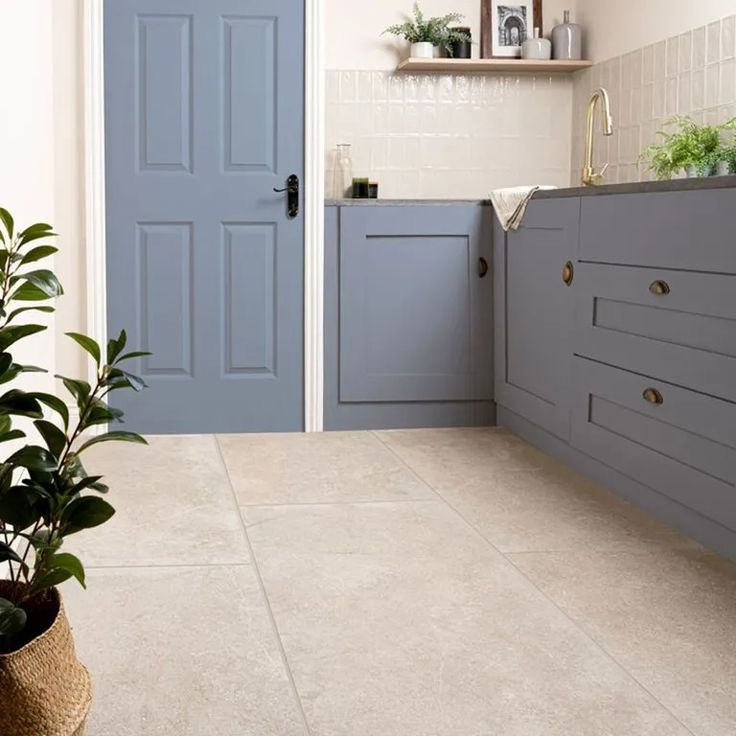Kitchens and bathrooms are two of the busiest rooms in any home. They face constant foot traffic, spills, and moisture, so you must be careful about the type of flooring you choose to avoid water damage, warping, or safety hazards like slipping.
For years, tiles have been the go-to option for these spaces because they are durable and water resistant. However, more homeowners are turning to hybrid flooring because it has the best features of laminate and vinyl that make it a stylish, waterproof, and comfortable alternative to tiles.
In this post, we learn why hybrid flooring options work better than tiles in kitchens and bathrooms. We’ll compare their key features, highlight the benefits of hybrid flooring, and guide you in choosing the right option for your home.
What Makes Hybrid Flooring Different from Tiles?
Hybrid flooring is a modern type of flooring that combines the strengths of laminate and vinyl into one durable and stylish option. It is designed to look like natural wood or stone while offering better water resistance, comfort, and durability than traditional flooring materials.
How Hybrid Flooring Combines Laminate and Vinyl Benefits
Here’s how hybrid flooring compares to other options:
1. Realistic Appearance Like Laminate
Laminate flooring is popular because it looks like real hardwood, thanks to a high-definition printed design layer. Hybrid flooring uses the same technology to achieve a realistic wood or stone appearance with natural textures and grain patterns. This means you get the warm, elegant look of timber flooring without the risk of water damage.
2. Waterproof Protection Like Vinyl
One of the biggest drawbacks of laminate flooring is how vulnerable it is to water. If exposed to moisture for too long, laminate planks can swell and warp. Vinyl flooring, on the other hand, is completely waterproof but sometimes lacks the realistic look of wood. Hybrid flooring solves this problem by combining the waterproof properties of vinyl with the stylish design of laminate. It has a rigid waterproof core that prevents swelling or warping, making it perfect for bathrooms and kitchens where spills and humidity are common.
3. Durability and Scratch Resistance
Hybrid flooring is built to withstand heavy foot traffic, making it ideal for busy households. It has a tough wear layer that protects against scratches, dents, and stains—something that both laminate and vinyl floors offer separately but are even stronger when combined. If you have pets with sharp claws or young children who love to run around, hybrid flooring holds up much better than traditional wood or laminate.
4. Comfort Underfoot and Noise Reduction
Unlike cold, hard tiles, hybrid flooring has a soft underlay that makes it more comfortable to walk on. It also reduces noise, making it a great choice for homes with multiple floors or open living spaces. This is especially helpful in apartments or houses where footsteps and dropped objects can be loud on hard flooring surfaces.
5. Hybrid Flooring Offers More Design Choices Than Tiles
Many homeowners love the look of hardwood floors, but real wood isn’t practical for kitchens and bathrooms due to its sensitivity to moisture. Hybrid flooring solves this problem by offering realistic wood-look designs with natural grain patterns, knots, and textures. You can find styles that mimic oak, walnut, hickory, and even reclaimed timber, allowing you to create a warm, inviting space without worrying about water damage.
When it comes to ceramic tiles, hybrid flooring comes in textured finishes that closely mimic real wood or stone. This not only enhances the visual appeal but also provides better grip and slip resistance, which is especially important in wet areas like bathrooms. Some hybrid floors have hand-scraped or wire-brushed textures that add depth and character, making them look and feel like authentic hardwood or stone.

How to Choose the Right Hybrid Flooring for Your Home
Choosing the right hybrid flooring requires you to consider durability, water resistance, slip resistance, and style to ensure your flooring is both practical and visually appealing. Here’s a guide to help you make the best choice for your kitchen and bathroom.
1. Pick the Right Thickness for Durability
Thicker planks provide better resistance to wear and tear, reduce noise, and feel more comfortable underfoot. For high-traffic areas like kitchens and bathrooms, a thickness of 5mm to 8mm is ideal. This ensures the floor withstands daily use while remaining comfortable to walk on. For homes with pets or kids, choosing the thicker end of the range (7mm–8mm) helps prevent dents and scratches.
2. Choose a Waterproof and Slip-Resistant Surface
Kitchens and bathrooms are high-moisture areas, so your flooring must be 100% waterproof to prevent swelling, warping, or mold growth. Not all hybrid floors offer the same level of water resistance, so look for a waterproof certification from the manufacturer.
For bathrooms and laundry rooms, select hybrid flooring with a fully sealed core and water-resistant backing to ensure long-lasting protection. Slip resistance is equally important. Look for hybrid floors with embossed textures or matte finishes, which offer better traction in wet areas.
3. Select a Style That Matches Your Home’s Design
Light-colored hybrid floors (such as oak or maple) create a bright, airy feel and make small spaces look bigger while dark -colored hybrid floors (such as walnut or charcoal) add warmth and elegance, making them perfect for modern or industrial-style kitchens. Matte finishes provide a natural and understated look, ideal for rustic, farmhouse, or Scandinavian-style homes while glossy finishes create a sleek and polished appearance, perfect for contemporary or luxury spaces.
Flooring That Works for Your Needs
Choosing the right hybrid flooring is easier when you buy from a trusted supplier that offers high-quality brands and expert advice. Online Flooring Store stocks a wide range of premium hybrid flooring options to help find the perfect match for your home’s style.












